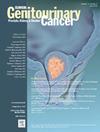Comparative Assessment of Chemotherapy Followed by Consolidative Radical Cystectomy Versus Chemoradiation for Clinically Node-Positive Urothelial Carcinoma of the Bladder
IF 2.7
3区 医学
Q3 ONCOLOGY
引用次数: 0
Abstract
Context
Patients with bladder cancer and clinically positive pelvic lymph nodes (cN+) have poor prognosis, and the optimal definitive treatment method remains controversial.
Objective
To compare survival outcomes between chemotherapy followed by radical cystectomy (RC) and chemoradiation (CRT) in patients with cN+ bladder cancer.
Methods
We queried the Surveillance, Epidemiology, and End Results (2000-2021) database to identify patients with cN+ bladder cancer treated with CRT or chemotherapy and RC. Cumulative incidence functions, Fine–Gray model, and Cox proportional hazards were used for the survival analysis. Inverse probability treatment weighting (IPTW) was used to adjust for confounders. The primary endpoints were cancer-specific mortality (CSM) and all-cause mortality (ACM).
Results
Among 552 patients identified, 175 (32%) received CRT and 377 (68%) underwent chemotherapy plus RC, and 5-year ACM was 75% (95% confidence interval [CI]: 71%-78%). RC and CRT were associated with 5-year CSM of 62% (95% CI: 57%-67%) and 72% (95% CI: 65%-78%), and 5-year ACM of 70% (95% CI: 65%-75%) and 85% (95% CI: 75%-90%), respectively. After IPTW, on multivariable Cox proportional hazard analysis adjusted for nodal and tumor staging, age, gender, tumor size and race, RC was associated with a significantly lower risk of CSM (hazard ratio [HR]: 0.47, 95% CI: 0.37-0.60, P < .001) and ACM (HR: 0.53, 95% CI: 0.46-0.60, P < .001).
Conclusions
Patients with cN+ bladder cancer who received CRT had a worse prognosis compared to those who underwent chemotherapy followed by RC. The incorporation of more effective systemic therapies is required to improve outcomes, as in our analysis, only one in four cN+ patients survived beyond 5 years.
化疗后巩固性根治性膀胱切除术与放化疗治疗临床淋巴结阳性膀胱尿路上皮癌的比较评价
膀胱癌合并临床阳性盆腔淋巴结(cN+)患者预后较差,最佳的最终治疗方法仍存在争议。目的比较cN+膀胱癌化疗后根治性膀胱切除术(RC)与放化疗(CRT)的生存结局。方法:我们查询监测、流行病学和最终结果(2000-2021)数据库,以确定接受CRT或化疗和RC治疗的cN+膀胱癌患者。生存率分析采用累积关联函数、Fine-Gray模型和Cox比例风险。采用逆概率处理加权(IPTW)对混杂因素进行校正。主要终点是癌症特异性死亡率(CSM)和全因死亡率(ACM)。结果在552例患者中,175例(32%)接受了CRT, 377例(68%)接受了化疗加RC, 5年ACM为75%(95%可信区间[CI]: 71%-78%)。RC和CRT与5年CSM的相关性分别为62% (95% CI: 57%-67%)和72% (95% CI: 65%-78%), 5年ACM分别为70% (95% CI: 65%-75%)和85% (95% CI: 75%-90%)。IPTW后,经淋巴结和肿瘤分期、年龄、性别、肿瘤大小和种族校正的多变量Cox比例风险分析显示,RC与CSM的风险显著降低相关(风险比[HR]: 0.47, 95% CI: 0.37-0.60, P <;.001)和ACM (HR: 0.53, 95% CI: 0.46-0.60, P <;措施)。结论cN+膀胱癌患者接受CRT的预后较化疗后RC差。需要结合更有效的全身治疗来改善预后,在我们的分析中,只有四分之一的cN+患者存活超过5年。
本文章由计算机程序翻译,如有差异,请以英文原文为准。
求助全文
约1分钟内获得全文
求助全文
来源期刊

Clinical genitourinary cancer
医学-泌尿学与肾脏学
CiteScore
5.20
自引率
6.20%
发文量
201
审稿时长
54 days
期刊介绍:
Clinical Genitourinary Cancer is a peer-reviewed journal that publishes original articles describing various aspects of clinical and translational research in genitourinary cancers. Clinical Genitourinary Cancer is devoted to articles on detection, diagnosis, prevention, and treatment of genitourinary cancers. The main emphasis is on recent scientific developments in all areas related to genitourinary malignancies. Specific areas of interest include clinical research and mechanistic approaches; drug sensitivity and resistance; gene and antisense therapy; pathology, markers, and prognostic indicators; chemoprevention strategies; multimodality therapy; and integration of various approaches.
 求助内容:
求助内容: 应助结果提醒方式:
应助结果提醒方式:


